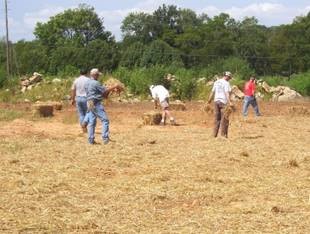Today’s Erosion and Sediment Control Tip: #15
The practice of Mulching can be used for temporary erosion control when a disturbed area is to be left for a while. Construction may not have finished on an area, or the time of the year is not right for permanent seeding. For whatever reason, mulching can be used. Straw mulches including wheat, barley, and rye (not ryegrass) are generally used for mulching material and are preferred over hay (bermudagrass, bahia, fescue, etc.) The straw mulches are more durable and last longer when exposed to our environment. Now the question is how much do I need? The recommended mulching rate for straw alone is 2.5 – 3.0 tons per acre. So, if a square straw bale weights 40 lbs, you would need between 125 and 150 bales per acre. This is a little tricky because straw bales may have different moisture contents that causes different weight for the same volume. However, this rate will get you very close to your objective, which is 100% ground coverage. After the straw is evenly applied, you should look at the straw surface and not be able to see ANY soil surface beneath. If you see soil, more mulch should be applied. Make sure that the straw is applied uniformly. Mechanical blowers are best for large areas. Hand spreading can be done for small areas. If the mulch is applied to an area where the mulch will not stay in place, you may need to add a tackifier or netting.
Other mulching materials (wood chips, bark, pine straw, and peanut hulls) could also be used according to recommended rates and with 100% ground cover. Hydraulic erosion control products, commonly referred to as hydromulch, are another option and should be applied according to the manufacturer's recommendation.
A good mulching job will prevent SPLASH erosion from
occurring and slow down SHEET erosion.
Erosion & Sediment Control Program Coordinator




Comments